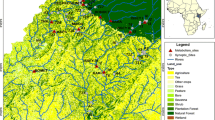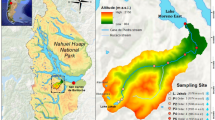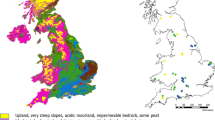Abstract
The percentage of wetlands in a catchment accounted for about half of the variance in transformed data for concentrations of dissolved organic carbon (DOC) in 42 Nova Scotian streams draining catchments with 11 different kinds of vegetation. Color increased with DOC, as did total dissolved nitrogen (TDN). Thecolor/DOC andDOC/TDN quotients also rose with increasing DOC, indicating a change in the quality of dissolved organic matter with increasing wetland influence. Dissolved Fe, and to a much lesser extent dissolved Al, showed a strong positive correlation with DOC. Stream pH showed a strong negative correlation with DOC, largely from wetlands, and a strong positive correlation with non- marine Ca2+ weathered from mineral soils. Non-marine SO4 2− from acid deposition had no apparent influence on stream pH and decreased with increasing streamwater DOC in summer, presumably owing to reduction processes in wetlands that mitigated the effects of acid deposition. Apparently, these reduction processes also produced small amounts of dissolved, non-ionic organic sulfur. Non-marine Ca2+ was related strongly to the percentage of upland hardwood forests in the catchments. Wetlands exert a profound influence on the chemistry of streams, principally through their export of DOC but also because of reduction reactions in their anerobic peats.
Similar content being viewed by others
Literature Cited
American Public Health Association. 1985. Standard Methods for the Examination of Water and Wastewater, 16th ed. American Public Health Association, Washington, DC, USA.
American Public Health Association. 1989. Standard Methods for the Examination of Water and Wastewater, 17th ed. American Public Health Association, Washington, DC, USA.
Anderson, L.E. 1990. A checklist ofSphagnum in North America north of Mexico. The Bryologist 93:500–501.
Anderson, L.E., H.A. Crum, and W.R. Buck. 1990. List of the mosses of North America north of Mexico. The Bryologist 93:448–499.
Anderson, R.F., and S.L. Schiff. 1987. Alkalinity generation and the fate of sulfur in lake sediments. Canadian Journal of Fisheries and Aquatic Sciences 44 (Suppl.):188–193.
Anonymous. 1993. Canadian Climate Normals 1961–90, vol 6, Atlantic Provinces. Ministry of Supply and Services, Ottawa, ON, Canada.
Bayley, S.E., R.S. Behr, and C.A. Kelly. 1986. Retention and release of S from a freshwater wetland. Water Air and Soil Pollution 31: 101–114.
Brakke, D.F., A. Henriksen, and S.A. Norton. 1987. The relative importance of acidity sources for humic lakes in Norway. Nature 329:432–434.
Cronan, C.S. 1979. Determination of sulfate in organically colored water samples. Analytical Chemistry 51:1333–1335.
Dalva, M. and T.R. Moore. 1991. Sources and sinks of dissolved organic carbon in a forested swamp catchment. Biogeochemistry 15:1–19.
David, M.B. and G.F. Vance. 1991. Chemical character and origin of organic acids in streams and seepage lakes of central Maine. Biogeochemistry 12:17–41.
Ecoregions Working Group. 1989. Ecoclimatic Regions of Canada, First Approximation. Canada Committee on Ecological Land Classification, Ecological Land Classification Series, No. 23. Sustainable Development Branch, Canadian Wildlife Service, Conservation and Protection, Environment Canada, Ottawa, ON, Canada.
Engstrom, D.R. 1987. Influence of vegetation and hydrology on the humus budgets of Labrador lakes. Canadian Journal of Fisheries and Aquatic Sciences 44:1306–1314.
Esslinger, T.L. and R.S. Eagan. 1995. A sixth checklist of the lichenforming, lichenicolous, and allied fungi of the continental United States and Canada. The Bryologist 98:467–549.
Fernald, M.L. 1950. Gray’s Manual of Botany, 8th ed. American Book Co., New York, NY, USA.
Gleason, H.A. and A. Cronquist. 1991. Manual of Vascular Plants of Northeastern United States and Adjacent Canada, 2nd ed. New York Botanical Garden, New York, NY, USA.
Gorham, E. 1991. Northern peatlands: role in the carbn cycle and probable responses to global warming. Ecological Applications 1: 182–195.
Gorham, E. 1995. The biogeochemistry of northern peatlands and its possible responses to global warming, p. 169–186.In G.M. Woodwell and F.T. Mackenzie (eds.) Biotic Feedbacks in the Global Climatic System. Oxford University Press, New York, NY, USA.
Gorham, E. and J.A. Janssens. 1992. The paleorecord of geochemistry and hydrology in northern peatlands and its relation to global change. Suo 43:9–19.
Gorham, E., S.J. Eisenreich, J. Ford, and M.V. Santelmann, 1985. The chemistry of bog waters, p. 339–362.In W. Stumm (ed.) Chemical Processes in Lakes. Wiley, New York, NY, USA.
Gorham, E., J.K. Underwood, F.B. Martin, and J.G. Ogden III. 1986. Natural and anthropogenic causes of lake acidification in Nova Scotia. Nature 324:451–453.
Grubbs, F.E. and G. Beck. 1972. Extension of sample sizes and percentage points for significance tests of outlying observations. Technometrics 14: 847–854.
Hemond, H.F.. 1980. Biogeochemistry of Thoreau’s Bog. Concord. Massachusetts. Ecological Monographs 50:507–526.
Hemond, H.F.. 1990. Wetlands as the source of dissolved organic carbon to surface waters, p. 301–313.In E.M. Perdue and E.T. Gjessing (eds.) Organic Acids in Aquatic Ecosystems. Wiley, New York, NY, USA.
Jeffries, D.S., D.L. Wales, J.R.M. Kelso, and R.A. Linthurst. 1986. Regional chemical characteristics of lakes in North America: Part 1—eastern Canada. Water Air and Soil Pollution 31:551–567.
Kahl, J.S., S.A. Norton, R.K. McRae, T.A. Haines, and R.B. Davis. 1989. The influence of organic acidity on the acid-base chemistry of surface waters in Maine, USA. Water Air and Soil Pollution 46:221–233.
Kerekes, J., S. Beauchamp, R. Tordon, and T. Pollock. 1986. Sources of sulphate and acidity in wetlands and lakes in Nova Scotia. Water Air and Soil Pollution 31:207–214.
Keys D. and R.E. Henderson. 1987. An investigation of the peat resources of New Brunswick. Open File Report 83-10, Minerals and Energy Division, Department of Natural Resources and Energy, Fredericton, NB, Canada.
Kortelainen, P. 1993. Contribution of organic acids to the acidity of Finnish lakes. Publications of the Water and Environment Research Institute, National Board of Waters and the Environment, Finland, No. 13. Painatuskeskus Oy, Helsinki, Finland.
McCurdy, R., R. Boss, S. Borgal, D. Borgal, and P. Norton. 1988. Determination of chloride in surface and groundwater by centrifugal analysis. Analyst 113:307–311.
McNicol, D.K., J. Kerekes, M.L. Mallory, R.K. Ross, and A.M. Scheuhammer. 1995. The Canadian Wildlife Service LRTAP Biomonitoring Program. Part 1. A Strategy to Monitor the Biological Recovery of Aquatic Ecosystems in Eastern Canada From the Effects of Acid Rain. Canadian Wildlife Service, Ottawa, ON, Canada, Technical report Series No. 245.
Norton, S.A., M.J. Handley, J.S. Kahl, and N.E. Peters. 1996. Reevaluation of colorimetric CI− data from natural waters with DOC. Water Air and Soil Pollution 91:283–298.
Nriagu, J.O., D.A. Holdway, and R.D. Coker. 1987. Biogenic sulfur and the acidity of rainfall in remote areas of Canada. Science 237: 1189–1192.
Odum, E.P. 1971. Fundamentals of Ecology. 3rd ed. Saunders, Philadelphia, PA, USA.
Ownbey, G.B. and T. Morley. 1991. Vascular Plants of Minnesota: a Checklist and Atlas. University of Minnesota Press, Minneapolis, MN, USA.
Peterson, R.C.. 1990. Effects of ecosystem changes (e.g., acid status) on formation and biotransformation of organic acids, p. 151–166.In E.M. Perdue and E.T. Gjessing (eds.) Organic Acids in Aquatic Ecosystems. Wiley-Interscience, New York, NY, USA.
Prairie, Y.T. and D.F. Bird. 1989. Some misconceptions about the spurious correlation problem in the ecological literature. Oecologia 81:285–288.
Rowe, J.S. 1972. Forest Regions of Canada. Canadian Forestry Service Publications, No. 1300.
Schindler, D.W., S.E. Bayley, P.J. Curtis, B.R. Parker, M.P. Stainton, and C.A. Kelly. 1992. Natural and man-caused factors affecting the abundance and cycling of dissolved organic substances in precambrian shield lakes. Hydrobiologia 229:1–21.
SigmaPlot. 1994a. Scientific Graphics Software for Windows, User’s Manual. Jandel Scientific Software, San Rafael, CA, USA.
SigmaStat. 1994b. Statistical Software for Windows, User’s Manual. Jandel Scientific Software, Rafael, CA, USA.
Sokal, R.R. and F.J. Rohlf. 1981. Biometry, 2nd ed. Freeman, New York, NY, USA.
Tarnocai, C., I.M. Kettles, and M. Ballard. 1995. Peatlands of Canada (a series of maps on a single sheet). Geological Survey of Canada Open File 3152.
Technicon. 1978. TOC in plant effluents. Technicon Instruments Corporation Bulletin, Industrial Method No. 535-78 IM, Technicon Instrument Comoration, Tarrytown, NY, USA.
Thurman, E.M. 1985. Humic substances in ground water, p. 87–103.In G.R. Aiken, P. McCarthy, D. McKnight, and R. Wershaw (eds.) Humic Substances, vol. 1, Geochemistry, Characterization and Isolation. Wiley, New York, NY, USA.
Tukhanen, S. 1984. A circumboreal system of climatic-phytogeographical regions. Acta Botanica Fennica 127:1–50.
Urban, N.R., E. Gorham, J.K. Underwood, E.B. Martin, and J.G. Ogden III. 1990. Geochemical processes controlling concentrations of Al, Fe, and Mn in Nova Scotia lakes. Limnology and Oceanography 35:1516–1534.
Wieder, R.K., J.B. Yavitt, and G.E. Lang. 1990. Methane production and sulfate reduction in two Appalachian peatlands. Biogeochemistry 10:81–104.
Author information
Authors and Affiliations
Rights and permissions
About this article
Cite this article
Gorham, E., Underwood, J.K., Janssens, J.A. et al. The chemistry of streams in southwestern and central Nova Scotia, with particular reference to catchment vegetation and the influence of dissolved organic carbon primarily from wetlands. Wetlands 18, 115–132 (1998). https://doi.org/10.1007/BF03161449
Received:
Revised:
Accepted:
Issue Date:
DOI: https://doi.org/10.1007/BF03161449




